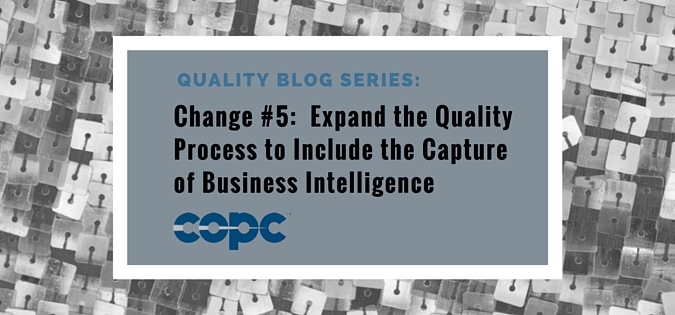
May 25, 2016
This is the fifth and final post in a special blog series called, “Five Changes to Your Quality Program That Can Dramatically Improve Customer Satisfaction.”
With each post in the series, we examined one of five fundamental changeswe recommend you make to your quality program. These are proven approaches to ensure your quality program is truly customer focused. Implementing these changes can drive significant improvements in the performance of your customer experience operations.
Here are the five changes:
#1. Redesign the quality form to align with key customer drivers
#2. Score only output metrics and use sub-attributes to capture reasons for error
#3. Measure quality using three metrics instead of one overall score
#5. Expand the quality process to include the capture of business intelligence
Today’s installment:
#5 Expand the quality process to include the capture of business intelligence
The call center and other customer-facing operations are excellent windows into gathering information on what customers are actually experiencing. Yet most organizations are missing the opportunity to capture this incredibly valuable information.
The majority of quality programs that COPC Inc. has seen deployed in customer experience operations simply evaluate what the employee did or did not do when handling a specific transaction. These evaluations are often times no more than a box-checking exercise in which the evaluator is going through a list of specific actions, such as “Did we greet the customer” “Did we use the customer’s name three times,” and “Did we thank the customer.”
While it is important to capture the details of what happens during a transaction, a quality evaluation can provide a wealth of information, if we take the time to listen to what the customer is actually experiencing.
Your customers are observant, sincere and opinionated. They have a lot to say about your products and services, as well as their personal experience with your brand. And they provide this input to you during every interaction.
Your quality program presents a prime opportunity for capturing and aggregating your customer’s experience with your brand. The sky is the limit about the type of information that can be captured. Here are some examples:
>Products—Are your customers experiencing numerous problems with a particular product?
>Marketing campaigns—Do customers love or hate a recently released marketing campaign? Or, did they even notice a new campaign was launched?
>Policies—What corporate policies are preventing customers from getting their issues resolved?
>Pricing—Are customers complaining about recent price increases?
>Dissatisfaction—What are the drivers of customer dissatisfaction with your product or service?
The power of collecting, aggregating, and providing this type of customer information to the appropriate departments cannot be understated. Your quality program is already established and listening to interactions with customers. We recommend you expand your program to capture this type of feedback.
If done properly, operations and other departments throughout your company will find this customer information invaluable. Your quality program will be seen as a trusted resource rather than simply a necessary expense.
______________________________________________________________________________
This concludes our series “Five Changes to Your Quality Program That Can Dramatically Improve Customer Satisfaction.” To learn more about how COPC Inc. can transform your quality program, contact Judi Brenstein at jbrenstein@copc.com.